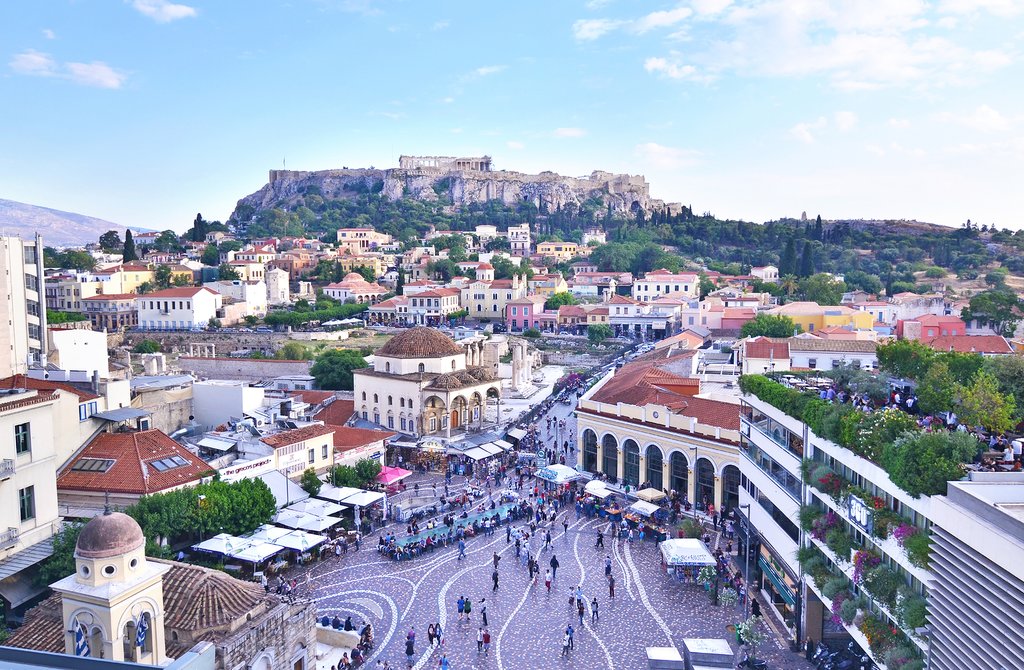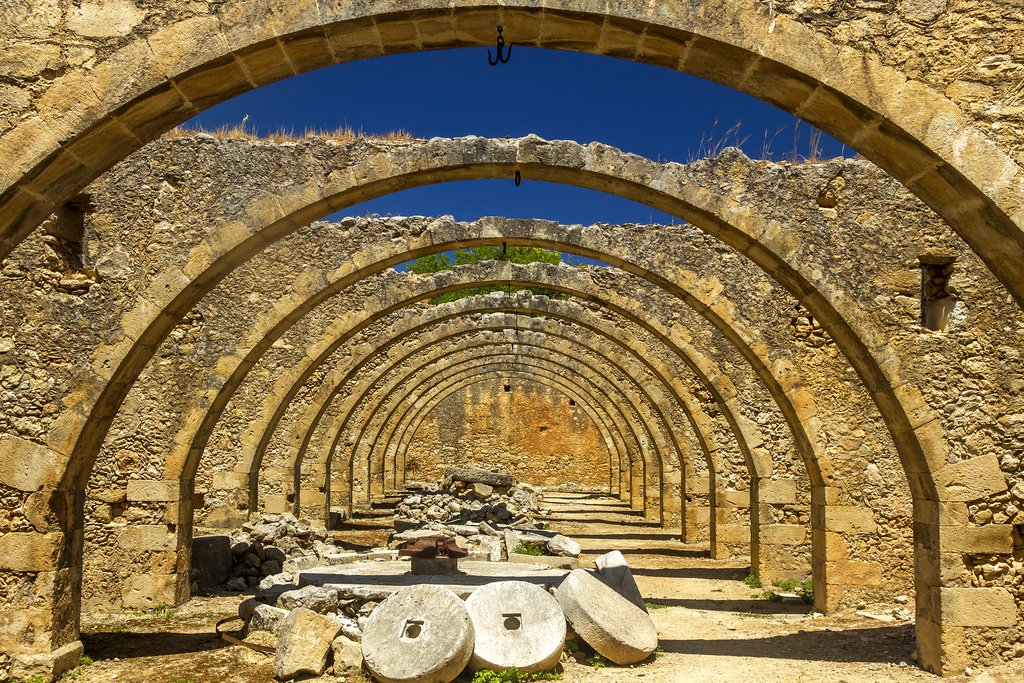Highlights
- Sip kitron at a local distillery on charming Naxos
- Visit a Cretan olive grove for a tour and tasting
- Get to know the seven historic villages of Apokoronas
- Take part in the seasonal harvesting of herbs, oranges, or wine grapes
Brief Itinerary
| Day | Highlights | Overnight |
|---|---|---|
| Day 1 | Arrive in Athens, Welcome Dinner | Athens |
| Day 2 | Ferry to Naxos | Naxos |
| Day 3 | Naxos Food Panorama, Ferry to Crete | Archanes |
| Day 4 | Olive Oil Tasting at Archanes | Archanes |
| Day 5 | Travel to Chania, Seasonal Agricultural Traditions | Chania |
| Day 6 | Explore the Villages of Apokoronas | Chania |
| Day 7 | Chania to Athens, Depart |
Detailed Itinerary
Day 1: Arrive in Athens, Welcome Dinner

Welcome to Greece! You'll begin your trip in Athens, home to both the iconic Acropolis and so much more. The mythology of this spectacular city precedes it, with towering temples to Classical deities and the ruins of ancient marketplaces rubbing shoulders with lively nightlife, crowded flea markets, and contemporary cuisine. Make the most of your time in the city at some of these spots:
- Check out the views of the can't-miss Parthenon. (Pro tip: The Parthenon is the temple, the Acropolis is the hill.) This temple to Athena has enchanted visitors since its construction was completed in 438 BC. It's probably the first thing that comes to your mind when you think of ancient Greece and is visible from many of the city's high points.
- Stop at the National Museum for a crash course in ancient iconography. Be sure to seek out the room housing the Antikythera mechanism, essentially an ancient astronomical computer.
- Visit a smaller archaeological site at the Tower of the Winds, then stroll down neighboring pedestrian Aiolou Street to stop at shops and cafes.
- Find your perfect souvenir or sun hat in the busy stalls of the Monastiraki flea market.
In the evening, you'll sit down to enjoy either a welcome dinner with views of the Acropolis or wine tasting in a bar in downtown Athens.
Day 2: Ferry to Naxos

Ferry to Naxos after breakfast. With an active main town where you can shop and admire the Venetian architecture, a historic Kastro (castle) area, and expansive beaches, the island offers opportunities for both laidback relaxation and water or land activities. The rest of the day is yours to unwind as you choose. Try out some of these options:
- Hike up to the summit of Mount Zas, the mythological childhood home of Zeus, the ruler of the gods, and the highest point in the Cyclades.
- Head inland to the town of Chalki, home to the island's oldest market and a petite, shady square perfect for whiling away the afternoon. Stop at the kitron distillery to sample the local liqueur and learn about its distillation process over the years.
- Visit the Temple of Demeter at Sangrion your way. Multiple deities of fertility were worshipped here, particularly the goddess Demeter. The temple was constructed in 530 BC, during the tyranny of Lygdamis, and represents a precursor of classical Athenian architecture.
- Stroll to the Portara, the entrance to the Temple of Apollo. Construction on the temple began in the sixth century BCE but was never finished, but the still-standing entranceway has become one of the hallmarks of the island. You can find it on the islet of Palatia, just over a causeway from the heart of Naxos Town (Chora).
For dinner, wander up the hill through the streets of the Kastro neighborhood to pick out your favorite of the area's tavernas, where you can sample the island's fresh produce in its best forms.
Chat with a local specialist who can help organize your trip.
Day 3: Naxos Food Panorama, Ferry to Crete

Taste some of the trademarks of the island known for having some of the best local produce in the Cyclades. Your guide will take you around the island to towns like Kindaros, Kaloxylos, Chalki, and the marble town of Apeiranthos, as well as the main Naxos town.
You'll meet with local producers to sample and even create some of the island's better-known dishes, such as loukoumades fried donuts, keftedes meatballs with tzatziki sauce and Naxian cheeses, and a cheese or olive pie picnic with coffee, juice, bread, fruit, and yogurt. You'll also sample the local kitron liqueur at a distillery before you top off the afternoon with a tour of the Venetian castle in the main town.
Once you've eaten your fill, you'll ferry over to Crete, the largest and most populous of the 230 inhabited Greek islands, and its capital city of Heraklion. From there, you'll be transferred to Archanes village.
Day 4: Olive Oil Tasting at Archanes

Olive oil is one of the keystones of Greek cuisine, and you'll get a hands-on look at its process with today's tour. Visit an olive farm and olive oil mill to learn about the many facets of olive harvesting, including the key role of timing and various harvesting methods. Taste the oil while you hear the stories of the owners of this family business and learn about the many uses of this ingredient.
The village of Archanes is also known for its raki, a traditional Cretan grape-based spirit used a welcome gesture for guests, appetizer, digestif, and more. If you're in town during harvest season, don't miss the kazanamata feast to celebrate the first raki of the season.
Day 5: Travel to Chania, Seasonal Agricultural Traditions

You'll transfer to Chania after breakfast. After you settle in, you'll take part in an agricultural activity in this beautiful region of Crete depending on the time of year. Cretan society moves with its seasons and there's always a tradition worth visiting. Take your pick from some of these activities:
- Orange picking (December - May): Stroll through fragrant orchards as you pick oranges straight from the trees. Utilize the fruits of your labor by learning some recipes from the orchard's resident cook.
- Herb gathering (December - May): Learn how to both identify and gather the many wild herbs growing on the island, then create salads, pies, or lamb and potatoes cooked in wine with your findings.
- Olive harvesting (November - December): The most classic of Greek products, olives are harvested from late November through the end of December. You'll greet the day early in the olive fields, picking from the trees until it's time to enjoy a light meal with the locals in the shade.
- Grape harvesting (August - September): Toast to the changing seasons with freshly picked grapes. You'll go from the vines to the wine press, seeing every part of the process and enjoying traditional wine and fresh grape dishes along the way.
- Raki distillation (October): October is the month of raki, Crete's famous local liquor, which is distilled in a specific 10-day period within the month. The exact dates vary, but it takes place roughly 40 days after the grapes have been harvested and follows a specific local procedure that you will learn. Join the event at the rakokazana distillery to partake in the creation and consumption of the seasonal feast.
In the afternoon, head back to Chania for dinner on the town. A few recommended local spots include:
- Oinoa: Wine bar and bistro in Chania town
- Mylos tou Kerata: Traditional Cretan restaurant with a garden view in the Platanias neighborhood
- Ntounias: Family-run spot close to the Botanical park & Gardens
Day 6: Explore the Villages of Apokoronas

Today, you'll have a chance to hear some of the island's history firsthand during a guided tour through nearby Apokoronas. The region's villages—seven of them—are home to a number of sites including an Ottoman fort, historic churches, and a folklore museum. But most interesting will be the conversations you and your guide will have with the local residents of the area.
Some potential highlights include:
- The hillside ruins at ancient Aptera, one of the largest city-states in Crete until it was destroyed by an earthquake in the seventh century, including a Minoan tomb believed to date back to roughly the 13th century BCE.
- Two-aisled churches in Stilos village from the 13th and 15th centuries, along with a limestone fossil once believed to be a fossilized sea siren and a walk along the Kiliaris river to a Venetian watermill.
- A glassblowing factory in Kokkino Chorio.
- The old square of Gavolochori, where you can visit the women's cooperative and see hand-knit lace created using a Byzantine technique or the neighboring Folklore Museum of Gavalochori.
In the evening, check out Chania's waterfront districts of Halepa and Tabakaria. Wander among former tanneries and factories in these off-the-beaten-track parts of town, just past the end of the main promenade.
Day 7: Chania to Athens, Depart

It's time to say farewell to Crete with one final breakfast in Chania. Take a sunrise stroll along the harbor or perhaps indulge in one more scoop of graviera cheese before you're transferred to the airport to head back to Athens for your departure.


